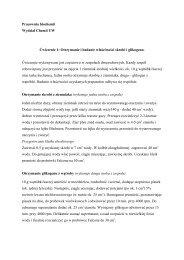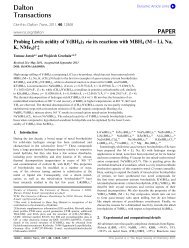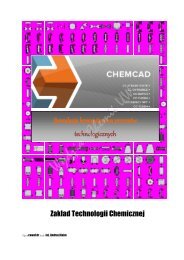Chem. Anal. (Warsaw), 53, 759
Chem. Anal. (Warsaw), 53, 759
Chem. Anal. (Warsaw), 53, 759
You also want an ePaper? Increase the reach of your titles
YUMPU automatically turns print PDFs into web optimized ePapers that Google loves.
766 Z. Hubicki, M. Wawrzkiewicz and A. Wo³owicz<br />
High values of distribution coefficients of noble metal ions (of the order of magnitude<br />
of 10 4 –10 6 ) and ion exchange capacities (0.74 mmol Au(III), 0.68 mmol Pd(II),<br />
0.39 mmol Pt(II), 0.31 mmol Pt(IV), 0.12 mmol Os(IV), 0.14 mmol Ir(IV), 0.02<br />
mmol Ir(III), 0.14 mmol Ru(III), 0.16 mmol Rh(III) per 1 g resin) indicate possible<br />
application of this polymer in separation of Pd(II), Pt(IV) and Au(III) ions from other<br />
ions.<br />
Chwastowska et al. [23] obtained the sorbent selective for Pt(IV) and Pd(II) ions<br />
(0.16 mmol g –1 ) by modification of the commercially available polyacrylic matrix of<br />
Diaion HP–2MG with dithizone. The obtained sorbent was found applicable in the<br />
recovery of the above mentioned ions from grass, dust, and soil samples collected<br />
near to the heavy traffic roads. Environmental samples were preliminarily cleaned<br />
and then digested using aqua regia and noble metals were separated on the dithizone<br />
sorbent. Desorption of palladium and platinum ions was possible using thiourea or<br />
concentrated nitric acid solutions. The major drawback of the sorbent used was its<br />
instability.<br />
The research on the applicability of macroporous styrene–divinylbenzene, cellulose<br />
or methacrylate ion exchangers modified with formazan (Fig. 8) is of significant<br />
importance in sorption and recovery of noble metal ions [24–26]. Owing to the significant<br />
ion exchange capacity for noble metal ions, this sorbent is recommended for<br />
selective recovery and separation of Pd(II) ions from Ni(II) and Co(II) ions.<br />
Figure 8. Formazane sorbent<br />
The macroporous styrene–divinylbenzene ion exchanger with thiosemicarbazide<br />
functional groups (Fig. 9) is characterized by the largest ion exchange capacity for<br />
Pd(II) ions (0.78 mmol g –1 ) in the presence of Pt(IV) (0.71 mmol g –1 ), Ru(III) (0.685<br />
mmol g –1 ) and Rh(III) (0.615 mmol g –1 ) ions. Effective separation (> 95.5%) of these







